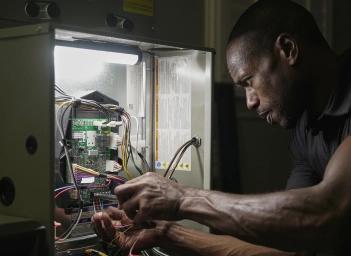Weatherization: Energy Efficiency Solutions for Your Home
Learn how home weatherization can keep your home warmer in the winter and cooler in the summer, and what programs can help you pay for upgrades.
By Anne Fonda
Do you feel a cold draft coming in around your windows and doors? Do your energy bills keep climbing even though the rates haven’t changed and you watch the thermostat like a hawk? If you answered yes to either of those questions, your home might benefit from some weatherization upgrades.
Why weatherization matters: 4 takeaways
The key benefits of weatherizing your home are:
- You increase your comfort.
- You decrease energy usage
- You can decrease your energy bills.
- You reduce your carbon footprint.
Keep reading to learn more about how to achieve all of those benefits.
Start with a home energy audit
The first thing to do is to identify problem areas where outside air is getting in and conditioned air is getting out. Many electric companies offer basic home energy audits to their customers at no cost or minimal cost. This basic walkthrough identifies gaps and leaks around doors and windows, assesses your insulation, and more. A free audit is a good place to start.
A more thorough energy audit will involve diagnostic testing and the energy audit cost will vary based on the tests conducted, the size of your home, and where you live. A home energy audit with diagnostic testing will come with a fee, but a tax credit can help pay for it.
Tests can include:
- Blower door test This test measures the volume of air escaping or entering the home.
- Duct test This test assesses your HVAC system’s ductwork, to identify leaky ducts or blockages disrupting airflow.
- Infrared imaging test This test uses infrared imaging to detect where outdoor air is entering the home and where heated or cooled air is escaping.
Either audit will produce recommendations for how you can weatherize your home and improve the energy efficiency of your HVAC system. A professional audit will be more detailed and have more specific recommendations based on test results.
Weatherization recommendations: Insulate, seal, and replace
A recent study by ICF Consulting shows that a whopping 89% of single-family homes in the United States are under-insulated. This leads to inefficient heating and cooling as well as higher energy bills.
It’s no wonder then that the top weatherization recommendations are: insulating, sealing, and replacing. Insulating and sealing are relatively inexpensive options that can have a big impact. Replacing old windows and doors can also make a huge difference.
Insulate
Nearly every home energy audit will result in a recommendation to increase insulation in at least part of your home. Insulation has what’s known as an R-value, which measures the insulation’s ability to resist heat traveling through it.
Be sure to choose the right insulation and the right R-value for the location in your home, as well as your climate. ENERGY STAR® has an easy-to-understand map and chart that you can refer to. If you’re handy around the house and have easy access to the attic or basement, you can install insulation yourself. Follow the links on the left-hand side for project instructions. You may also wish to hire insulation contractors.
In addition to attic insulation, basement insulation, and crawl space insulation projects, if you have an attached garage, think about insulating it. If it’s a finished garage, the walls may already be insulated. If it’s unfinished, you can easily install batt insulation.
Don’t forget about garage door insulation. If you can see sunshine or feel the wind blowing at the sides or bottom of your garage door, it’s time to replace the garage weatherstripping. It’s relatively inexpensive and easy to install.
Consider adding insulation to the garage door itself - search online for kits. If you’re thinking about replacing your garage door, upgrade to an insulated garage door. Keeping hot and cold air out of an attached garage helps regulate the temperature in the garage and the rooms next to it and above it.
Seal, caulk, and add weatherstripping
Anywhere there are gaps around windows or doors, you will want to seal, caulk, or add weatherstripping. Follow the recommendations you received in your home energy audit. Window caulking and adding weatherstripping for doors can be a simple DIY project. All of the materials you need are readily available at a local hardware or home improvement store. But this is also a task that any handyman can tackle.
Get more tips on sealing and insulating your home from ENERGY STAR®.
Replace
Windows If you have old, single-pane windows, they can be a big source of heat loss/heat gain. Consider investing in window replacement with ENERGY STAR®-certified windows. These windows are at least double-paned and insulated to provide you with energy savings. Installing replacement windows is a job best left to the professionals, especially if you want to ensure your warranty is valid.
Skylights If you’re planning on roof replacement, consider replacing your skylights at the same time (if you have them). Older skylights can be discolored and don’t fit as well as they used to, letting in water and letting hot or cold air in. Newer models have improved insulation and energy efficiency. You can also replace skylights without replacing your roof. It’s just a little more complicated. Be sure to work with trained professionals.
Exterior doors While you can replace exterior doors for cosmetic reasons, the most important reason to replace them is if they are cracked, rotting, or there is moisture trapped in the windows of a door. Replacing old doors with new, better-insulated ones can help save energy and lower your heating and cooling bills. This includes patio doors. Check out these tips from energy.gov for selecting the right doors.
Make energy-efficient upgrades that qualify for tax credits
If you want to save energy and get rewarded for making energy-efficient upgrades to your home, make upgrades that are eligible for tax credits. It means buying and installing ENERGY STAR®-qualified products ranging from insulation to a heat pump.
You then apply for the tax credits when you do your taxes. So be sure to save the receipts. Until 2032, you may be eligible for up to $3,200 in federal tax credits each year for qualifying home energy efficiency upgrades.
Projects can include:
- Home energy audit
- Windows and skylights
- Doors
- Insulation
- Heat pump installation
- Furnace replacement
- Air conditioner replacement
- Electric panel upgrade
You don’t have to try and do the updates all at once. Start with the home energy audit, and budget for upgrades each year.
Check your HVAC duct system for leaks
If your home energy audit didn’t include an assessment of your HVAC ductwork, you can take a look for signs of leaky ducts. Look for visible gaps in exposed ductwork (often in an attic or unfinished basement). If your home is older, there’s a good chance that you have leaky ductwork. An HVAC professional can perform testing to identify trouble spots and offer solutions.
Leaky ductwork can lead to heat loss, hot and cold spots, and lots of dust in your home. Duct sealing with Aeroseal® can seal hidden ductwork from the inside. Exposed ductwork can be sealed with mastic sealant or HVAC tape.
Home energy assistance program
If you’re a senior on a limited income or you’re struggling to get by financially, this may all sound like more than you can afford. The good news is the U.S. Department of Energy (DOE) Weatherization Assistance Program (WAP) can help. The weatherization program for low-income households provides money-saving weatherization improvements and upgrades using federal funds.
Check to see if you’re eligible for weatherization assistance. Each state may have different criteria. Each state also keeps a list of weatherization providers authorized to do the work on your home.
What does weatherization cover?
Under the WAP program, based on an evaluation of your home, this energy assistance program may cover:
- HVAC repair or replacement
- Duct insulation
- Duct sealing
- Programmable thermostat
- Insulation upgrades
- Sealing of windows and doors
- Window and door replacement
- Minor roof repairs
- Other energy-saving improvements
Once you apply for assistance, you’ll work with your state and approved service providers.
Work with HVAC experts
If you think you may have leaky ducts, schedule an evaluation with your local Trane dealer. You may be able to combine this with another service such as an AC tuneup or furnace tuneup. If you’re considering HVAC system replacement in the near future, you can also schedule a quote with product recommendations tailored to your heating and cooling needs.
Anne Fonda, Content Writer
A Content Writer with Trane Technologies, Anne Fonda researches topics and writes for Trane® and associated residential HVAC brands. She works in collaboration with Trane Technologies subject matter experts, offering easy-to-understand, informative content on complex topics. Her goal is to help consumers make informed decisions on the products and services they need.
She has written for HVAC and other service provider websites for over 16 years. Before transitioning to web content writing, Anne had a 14-year stint as an award-winning journalist. She graduated cum laude from the University of Missouri-Columbia School of Journalism.
When she’s not working, Anne enjoys playing word games, reading, gardening, spending time with family, and visiting gardens and museums.
Expert review by Erin Smith, Product Marketing Manager




